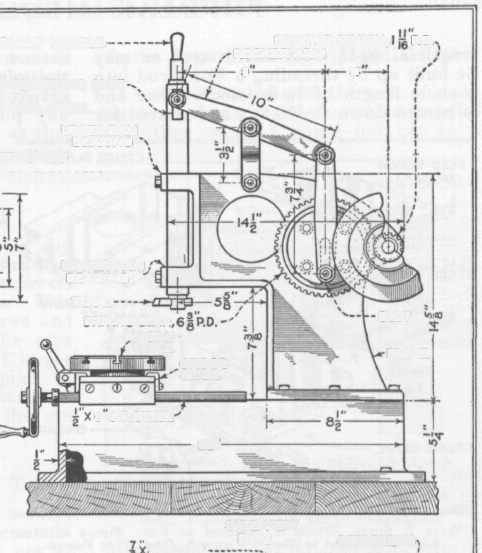duncanbojangles
Member
- Joined
- Sep 29, 2012
- Messages
- 9
- Reaction score
- 1
I'm a lurker on this forum, and I need help identifying a linkage system so that I can design a similar one. The picture is from J.V. Romig's article, "Making a Four-Inch Bench Slotter" and is the side view of his designed slotter. I'm interested in the mechanism that turns rotary motion into reciprocating motion. I've looked at and read about 4 bar linkages and 6 bar linkages, and I can see that this is one or the other of these, but I can't figure out which. If someone can identify exactly what type of linkage system this is, I think I can design one that fits my needs exactly.

romig bench slotter by duncanbojangles, on Flickr
To give you an idea of what I'm trying to accomplish, I am also trying to build a small bench slotter. My plan is probably a bit daft, but I've got a 1/2 ton arbor press that I'll use for most of the frame, and I'll beef up the portion that will house the ram. I've got some gears to slow things way down (105 teeth and 28 teeth) and I'm using a purchased X-Y table instead of trying to build my own (though I've got some wonderful linear slides if I do try to build my own).
I'm interested in Romig's mechanism because it turns rotary motion into straight line reciprocating motion over the whole 360 degrees the input rotates, without resorting to slides (other than the ram's motion, but that one is desired. ) The slides you do see in the picture are for adjustment of the ram's stroke and position. I've looked at several of the approximate straight-line mechanisms, like Watt's linkage, and Chebyshev's linkage, and the exact straight-line mechanisms, like Watt's parallel motion linkage, but can't find an exact match to Romig's mechanism.
) The slides you do see in the picture are for adjustment of the ram's stroke and position. I've looked at several of the approximate straight-line mechanisms, like Watt's linkage, and Chebyshev's linkage, and the exact straight-line mechanisms, like Watt's parallel motion linkage, but can't find an exact match to Romig's mechanism.
I'm trying to design a similar linkage system in AutoCAD, but not having much luck. I thought I might stumble upon a simple geometric solution, but I don't know enough to even know where to begin. Thanks in advance, and I promise to post build photos if I succeed in building a bench slotter (and maybe even if I don't!).

romig bench slotter by duncanbojangles, on Flickr
To give you an idea of what I'm trying to accomplish, I am also trying to build a small bench slotter. My plan is probably a bit daft, but I've got a 1/2 ton arbor press that I'll use for most of the frame, and I'll beef up the portion that will house the ram. I've got some gears to slow things way down (105 teeth and 28 teeth) and I'm using a purchased X-Y table instead of trying to build my own (though I've got some wonderful linear slides if I do try to build my own).
I'm interested in Romig's mechanism because it turns rotary motion into straight line reciprocating motion over the whole 360 degrees the input rotates, without resorting to slides (other than the ram's motion, but that one is desired.
I'm trying to design a similar linkage system in AutoCAD, but not having much luck. I thought I might stumble upon a simple geometric solution, but I don't know enough to even know where to begin. Thanks in advance, and I promise to post build photos if I succeed in building a bench slotter (and maybe even if I don't!).































































